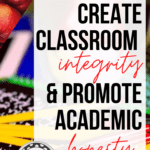Academic dishonesty is an unfortunate reality. Students have countless reasons for committing academic dishonesty, which includes plagiarism and cheating. In the ELA world, students “borrowing” papers from friends, buying them online, and/or recycling their own work all pose significant problems. How can teachers combat this challenge? And how can we make students our partners in this pursuit?

This post this post may contain affiliate links. Please read the Terms of Use.
Define and Collaborate
Define the problem. Before teachers can make students partners in the fight against academic dishonesty, we have to be explicit about the problem. Clearly define the scope of “academic dishonesty.” And clearly communicate that definition to students, parents, and other stakeholders. The easiest way to do this is through your syllabus. In addition, include this definition on assignment sheets. I include a blurb about academic dishonesty and its consequences on the assignment sheet for all major projects, papers, and presentations. Turnitin.com also provides a free quiz to help students learn about plagiarism.
Work together. One or two educators cannot fight academic dishonesty alone. So enlist your team, department, and administration in this endeavor. Last year, my department developed a specific department policy, which was in line with building and district policy. This proved to be helpful because now we share a definition and language. Similarly, we have universal consequences. Most importantly, we have the support of our administrators. If everyone approaches the issue in the same, consistent manner, students will recognize that there’s nowhere to hide.
Create a Culture Against Academic Dishonesty
Create a culture of integrity. With a clearly defined problem and a collaborative approach to tackling the issue, educators can focus on building a culture that promotes integrity. We’ve all seen the cheesy character-promoting programs that come into buildings and hang a few signs. But that’s not enough. We have to live integrity and model it for our students everyday.
- First, admit when you have made a mistake so students have a model of how to admit and fix mistakes.
- In addition, every time you reference or quote someone else’s work (whether in a Google Slides, on a handout, or verbally), include an attribution.
- Further, the ELA classroom is the perfect place to consistently point to examples of integrity (Atticus Finch) and examples of action without integrity (Cassius).
- Finally, reward and celebrate integrity. When your students make a choice that exemplifies high character, point it out and celebrate. There doesn’t have to be a tangible reward like a gold sticker, but a smile or a fist bump is great positive reinforcement.
If all of these sound like small ideas–they are. Culture doesn’t come from one large action: culture is the culmination of countless small actions.

Empowering Students Against Academic Dishonesty
Empowering students begins by making students partners in the pursuit of academic honesty. To do this, make sure students have the right tools and resources.
- Make sure students know about great resources like the Purdue OWL or the MLA Style Center.
- Help students determine the credibility of sources.
- Make sure students know where to locate key citation information. The librarians at my school do a great job sharing the library databases with students. They also model the process of finding citations.
- Provide students with clear expectations of how they will be assessed. Academic dishonesty often appears as a response to unclear expectations. So make sure students have a checklist or rubric ahead of time.
- Make sure you have all the resources you need for working on this important issue. Check out this Pinterest board for more ideas about promoting academic honesty.
Regardless of which tools you use, it’s important that students have easy access to these tools, know how to use them, and have time to employ and experiment with them. How do you respond to academic dishonesty? Let us know your best suggestions in the comments.











